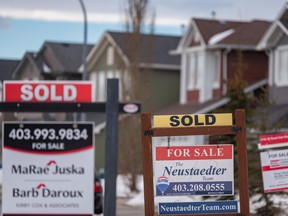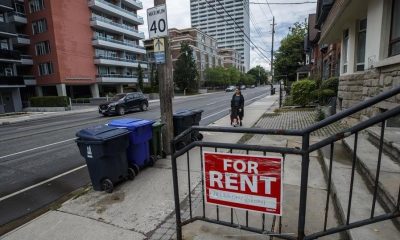For a brief, shining moment in the spring of 2022, it appeared that some semblance of sanity was returning to the most unhinged real estate market in the world.
Real eState
Great Canadian housing bailout: How real estate unaffordability is being propped up

But the moment is over. The price drops slowed, the unaffordability ratchet held fast, and untold millions abandoned their last lingering hope of owning their own home. Real estate publications praised the country’s return to “normalcy” although normalcy, in this case, referred to annual double-digit spikes in value that remained wholly detached from local economic conditions.
Only a year later, it’s happening again: Under normal conditions, a central bank hiking interest rates to 4.75 per cent would be expected to send housing prices into a slump. But almost everywhere, real estate professionals are confident the juggernaut is going to continue. In its official reaction to the higher rate, a spokesperson for the B.C. Real Estate Association said prices would remain “extraordinarily resilient” and that the higher rates would probably not “make that much of a difference.”
In an April Ipsos poll, a record 63 per cent of Canadians not already in a possession of a home said they had “given up” any hope of owning one. As of the most recent numbers from the Canadian Real Estate Association, the average price of a Canadian home has bounced back to $716,000. Even adjusting for inflation, that’s nearly three times higher than the average Canadian home price in the year 2000.
And yet, when finance minister Chrystia Freeland tabled the 2023 federal budget in March, one of the most remarkable things about it was the fact that it didn’t have a single policy designed to increase the overall housing supply.
While prior budgets had at least paid lip service to the notion of bringing down real estate prices, the new measures in Federal Budget 2023 were focused entirely on the demand-side of the equation. The government would not be making homes more affordable, but they would be making it just a bit easier to bid up the homes that were already in place.
There was the Tax-Free First Home Savings Account, which would allow Canadians to stash away $40,000 for a downpayment, tax-free. Tax credits were increased for first-time homebuyers. Millions of Canadians were also just straight-up handed an extra $500 through a one-time expansion to the Canadian Housing Benefit.
“Canada’s 2022 budget is already trying to bail out real estate by creating demand,” declared an analysis by Better Dwelling.
In Metro Vancouver, this even led to absurd scenes like wealthy lawyers organizing demonstrations to protest against having to pay “outrageous” interest rates on their real estate portfolios. “Stop discriminating against homeowners,” read a placard at one such protest in Surrey, B.C.
One of these relief measures is the extension of amortization terms. In recent months, all of Canada’s big banks have reported a vast expansion in the number of mortgages on their books with amortization periods of 35 years or longer.
For borrowers, that means their monthly payments go down, but they have to keep paying them for an extra 10 to 15 years.
Either way, the effect is that Canadians are able to handle larger amounts of credit, which is further increasing the amount of money available to bid up prices. What’s more, it’s rewarding the ranks of overleveraged real estate buyers who helped bid up the market in the first place.
In a May letter to the House of Commons Standing Committee on Finance, the regulator said that one of the easiest ways for Parliament to bring down real estate prices would be to ban banks from doing this.
“Removing the ability to extend amortization periods could exert downward pressure on some house prices, as it reduces the options available to help some borrowers meet their financial obligation,” it read.
And overarching everything is the fact that Canada is ratcheting up immigration to unprecedented levels. In 2022 alone, one million new people came to Canada, the direct result of a stated push by the Trudeau government to increase GDP by significantly dialling up immigration intake.
In January, University of Calgary economist Arvind Magesan told the National Post in an email that, given current conditions, it’s “hard to see” how the current state of Canadian immigration policy would not be piling pressure on top of the already stressed real estate market.
“I would like to hear a counter argument to this (but) I don’t see one,” he said. “And I say this as a proponent of immigration for both economic and philosophical reasons — we need immigration for other economic reasons.”
The core problem in Canadian housing affordability has always been a simple scarcity of homes. Foreign capital has played a part in juicing demand, but there’s no escaping the fact that Canada has developed the most acute housing shortage of any other country in the G7.
In a report last June, the Canadian Mortgage and Housing Corporation estimated that it would take the construction of 3.5 million more homes to return Canada to the level of affordability last seen in 2003, one of the last years in which it was still technically feasible for a household earning an average income to afford a home in a major centre such as Toronto or Vancouver.
And it’s this factor that remains the most reliable bulwark propping up Canadian real estate unaffordability. Strict municipal zoning laws ensure that it remains illegal to build anything but a single-family home within the boundaries of hyper-stressed markets like Vancouver or Toronto. Any attempt to densify in the face of existing zoning restrictions is likely to encounter an odyssey of red tape and public hearings.
View Royal, a municipality within B.C.’s Greater Victoria region, recently announced that it was going to stop considering any rezoning proposals whatsoever for the next six months. Greater Victoria had just become one of the country’s most expensive housing markets, immigration was reaching record highs and even after repeated annual rent increases of as much as 20 per cent, the regional vacancy rate still stood at nearly zero.
But according to a resolution, all these factors took a back seat to the municipality’s need to take an extended break to “ensure that all development initiatives align with the long-term goals and interests of the community.”

Real eState
Greater Toronto home sales jump in October after Bank of Canada rate cuts: board

TORONTO – The Toronto Regional Real Estate Board says home sales in October surged as buyers continued moving off the sidelines amid lower interest rates.
The board said 6,658 homes changed hands last month in the Greater Toronto Area, up 44.4 per cent compared with 4,611 in the same month last year. Sales were up 14 per cent from September on a seasonally adjusted basis.
The average selling price was up 1.1 per cent compared with a year earlier at $1,135,215. The composite benchmark price, meant to represent the typical home, was down 3.3 per cent year-over-year.
“While we are still early in the Bank of Canada’s rate cutting cycle, it definitely does appear that an increasing number of buyers moved off the sidelines and back into the marketplace in October,” said TRREB president Jennifer Pearce in a news release.
“The positive affordability picture brought about by lower borrowing costs and relatively flat home prices prompted this improvement in market activity.”
The Bank of Canada has slashed its key interest rate four times since June, including a half-percentage point cut on Oct. 23. The rate now stands at 3.75 per cent, down from the high of five per cent that deterred many would-be buyers from the housing market.
New listings last month totalled 15,328, up 4.3 per cent from a year earlier.
In the City of Toronto, there were 2,509 sales last month, a 37.6 per cent jump from October 2023. Throughout the rest of the GTA, home sales rose 48.9 per cent to 4,149.
The sales uptick is encouraging, said Cameron Forbes, general manager and broker for Re/Max Realtron Realty Inc., who added the figures for October were stronger than he anticipated.
“I thought they’d be up for sure, but not necessarily that much,” said Forbes.
“Obviously, the 50 basis points was certainly a great move in the right direction. I just thought it would take more to get things going.”
He said it shows confidence in the market is returning faster than expected, especially among existing homeowners looking for a new property.
“The average consumer who’s employed and may have been able to get some increases in their wages over the last little bit to make up some ground with inflation, I think they’re confident, so they’re looking in the market.
“The conditions are nice because you’ve got a little more time, you’ve got more choice, you’ve got fewer other buyers to compete against.”
All property types saw more sales in October compared with a year ago throughout the GTA.
Townhouses led the surge with 56.8 per cent more sales, followed by detached homes at 46.6 per cent and semi-detached homes at 44 per cent. There were 33.4 per cent more condos that changed hands year-over-year.
“Market conditions did tighten in October, but there is still a lot of inventory and therefore choice for homebuyers,” said TRREB chief market analyst Jason Mercer.
“This choice will keep home price growth moderate over the next few months. However, as inventory is absorbed and home construction continues to lag population growth, selling price growth will accelerate, likely as we move through the spring of 2025.”
This report by The Canadian Press was first published Nov. 6, 2024.
The Canadian Press. All rights reserved.
Real eState
Homelessness: Tiny home village to open next week in Halifax suburb

HALIFAX – A village of tiny homes is set to open next month in a Halifax suburb, the latest project by the provincial government to address homelessness.
Located in Lower Sackville, N.S., the tiny home community will house up to 34 people when the first 26 units open Nov. 4.
Another 35 people are scheduled to move in when construction on another 29 units should be complete in December, under a partnership between the province, the Halifax Regional Municipality, United Way Halifax, The Shaw Group and Dexter Construction.
The province invested $9.4 million to build the village and will contribute $935,000 annually for operating costs.
Residents have been chosen from a list of people experiencing homelessness maintained by the Affordable Housing Association of Nova Scotia.
They will pay rent that is tied to their income for a unit that is fully furnished with a private bathroom, shower and a kitchen equipped with a cooktop, small fridge and microwave.
The Atlantic Community Shelters Society will also provide support to residents, ranging from counselling and mental health supports to employment and educational services.
This report by The Canadian Press was first published Oct. 24, 2024.
The Canadian Press. All rights reserved.
Real eState
Here are some facts about British Columbia’s housing market

Housing affordability is a key issue in the provincial election campaign in British Columbia, particularly in major centres.
Here are some statistics about housing in B.C. from the Canada Mortgage and Housing Corporation’s 2024 Rental Market Report, issued in January, and the B.C. Real Estate Association’s August 2024 report.
Average residential home price in B.C.: $938,500
Average price in greater Vancouver (2024 year to date): $1,304,438
Average price in greater Victoria (2024 year to date): $979,103
Average price in the Okanagan (2024 year to date): $748,015
Average two-bedroom purpose-built rental in Vancouver: $2,181
Average two-bedroom purpose-built rental in Victoria: $1,839
Average two-bedroom purpose-built rental in Canada: $1,359
Rental vacancy rate in Vancouver: 0.9 per cent
How much more do new renters in Vancouver pay compared with renters who have occupied their home for at least a year: 27 per cent
This report by The Canadian Press was first published Oct. 17, 2024.
The Canadian Press. All rights reserved.
-

 News5 hours ago
News5 hours agoEnergy experts think Donald Trump will make tariff exemptions for Canadian oil
-

 News23 hours ago
News23 hours agoBad traffic, changed plans: Toronto braces for uncertainty of its Taylor Swift Era
-

 News5 hours ago
News5 hours agoRent inflation to slow in the next few years, Desjardins predicts
-

 News5 hours ago
News5 hours agoTrudeau off to APEC in Peru, G20 summit in Brazil as peer nations brace for Trump
-

 News5 hours ago
News5 hours agoWatchdog says Tims card brouhaha shows N.S. electoral officer needs fining power
-

 News5 hours ago
News5 hours agoHospitality workers to rally for higher wages as hotel costs soar during Swift tour
-

 News4 hours ago
News4 hours agoNova Scotia election: Liberals promise to improve cellphone services and highways
-

 News4 hours ago
News4 hours agoTrain derailment and spill near Montreal leads to confinement order


















